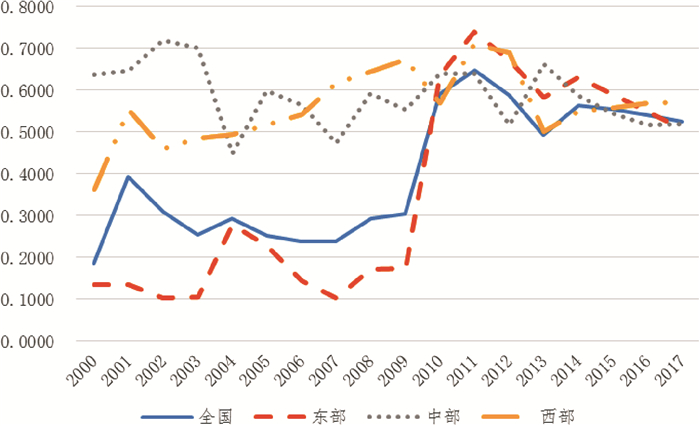Economic Catching-up, Public Expenditure Bias and Urban-rural Public Services Gap
-
摘要: 构建政府支出偏向对城乡公共服务差距影响的理论模型,探讨经济赶超背景下政府公共支出决策对城乡公共服务非均衡发展的传导路径和影响机制,基于生产性公共服务和消费性公共服务两个维度,重构和测度城乡公共服务均等化指数,提出研究假设并运用2000—2017年的省级面板数据进行检验。结果显示:我国城乡公共服务差距呈逐步扩大趋势,且消费性公共服务城乡差距大于生产性公共服务城乡差距;落后省份的经济赶超行为使地方政府偏好生产性支出,而增加生产性政府支出将导致城乡公共服务差距进一步扩大。为此,应改变政绩考核机制,完善省以下财政管理体制,合理划分中央与地方的事权与支出责任,创新农村公共产品供给机制,以构建实现城乡公共服务均衡发展的有效路径。Abstract: Through constructing a theoretical model for interpreting the impact of government expenditure bias on the gap between urban and rural public services, it is aimed to explore the transmission path and influence mechanism of public expenditure decision-making on the unbalanced development of urban and rural public services under the background of economic catch-up, reconstruct and measure the equalization index of urban and rural public services based on the two dimensions of productive public services and consumptive public services, to make empirical test under the research hypothesis with the provincial panel data from 2000 to 2017. The results show that, the gap between urban and rural public services is gradually expanding, and the gap of consumer public services between urban and rural areas is larger than that of productive public services; the economic catch-up behavior of backward provinces makes local governments prefer productive expenditure, while increasing productive government expenditure will lead to the expansion of urban-rural public service gap. Therefore, the government should change the evaluation mechanism, improve the financial management system below the provincial level, reasonably divide the powers and expenditure responsibilities between the central and local governments, innovate the supply mechanism of rural public goods, and build an effective path to realize the balanced development of urban and rural public services.
-
表 1 城乡公共服务均等化指标体系
综合指标(目标层) 一级指标(准则层) 指标符号 二级指标(方案层) 城乡公共服务差距指数 消费性公共服务 生产性公共服务 A1 每千人口城市执业医师数/每千人口农村执业医师数 A2 每千人口城市注册护士数/每千人口农村注册护士数 A3 每千人口城市卫生技师数/每千人口农村卫生技师数 A4 每千人口城市卫生管理人员数/每千人口农村卫生管理人员数 社会保障 B1 城镇居民从业人员占比/农村居民从业人员占比 B2 城镇居民最低生活保障人数占比/农村居民最低生活保障人数占比 B3 城镇居民家庭恩格尔系数/农村居民家庭恩格尔系数 B4 城镇居民人均转移性收入/农村居民人均转移性收入 生产性公共服务 基础教育 C1 城市小学生均专任教师数/农村小学生均专任教师数 C2 城市小学生均办学图书藏量/农村小学生均办学图书藏量 C3 城市小学生均教职工数/农村小学生均教职工数 C4 城市小学生均校舍建筑面积/农村小学生均校舍建筑面积 基础设施 D1 城市人均固定资产投资额/农村人均固定资产投资额 D2 每万人公路里程数/每万人四级及等外公路里程数 D3 城市人均固定电话用户数/农村人均固定电话用户数 D4 每万人城市文化站机构数/每万人乡镇文化站机构数 表 2 城乡公共服务均等化指数
年份 医疗卫生 社会保障 消费性公共服务 基础教育 基础设施 生产性公共服务 综合指数 2000 0.546 1 0.382 4 0.249 4 0.379 8 0.401 2 0.038 6 0.186 5 2005 0.563 2 0.329 1 0.371 1 0.359 0 0.405 4 0.085 9 0.251 6 2010 0.513 5 0.283 1 0.745 0 0.367 2 0.383 8 0.031 4 0.591 1 2011 0.617 6 0.227 4 0.852 5 0.371 8 0.369 1 0.052 2 0.646 9 2012 0.586 1 0.229 0 0.833 5 0.398 1 0.410 0 0.020 8 0.587 8 2013 0.596 8 0.264 3 0.709 8 0.416 8 0.386 6 0.053 1 0.493 6 2014 0.627 3 0.258 9 0.796 8 0.422 4 0.439 5 0.028 1 0.563 6 2015 0.604 7 0.231 7 0.695 3 0.463 2 0.451 6 0.031 9 0.554 1 2016 0.613 8 0.263 5 0.652 3 0.413 7 0.413 9 0.034 5 0.541 2 2017 0.576 1 0.247 8 0.701 9 0.389 1 0.396 2 0.051 2 0.524 7 表 3 主要变量的描述性统计结果
元,% 变量 变量涵义 最小值 最大值 均值 标准差 CV 城乡公共服务均等化指数 0.057 1.154 0.542 0.232 EP 人均生产性政府支出 144 40 637 2 365 2 891 CI 经济赶超指数 0.117 8.132 2.478 1.815 Uep 城市生产性支出占生产性政府支出的比重 67.012 90.371 88.158 7.134 Gdpp 人均GDP 2 759 118 597 27 156 21 632 Tis 第三产业占比 29.700 81.412 43.192 8.194 Urb 城市化指数 13.890 92.374 48.329 16.742 Openess 对外开放程度 0.043 2.157 0.491 0.558 FDit 财政分权程度 0.053 1.351 0.574 0.319 表 4 基准回归实证结果
变量 (1)FE (2)FE (3)FE EP 0.005 3** (0.867 2) 0.016 1* (0.741 2) 0.014 2* (0.493 8) CI 0.020 1** (0.023 1) 0.015 4** (0.020 9) Uep 0.004 8* (0.003 7) FD 0.514 2** (0.176 1) 0.501 3** (0.201 3) 0.564 5** (0.169 1) LnGdpp -0.046 8* (0.021 6) -0.050 1* (0.031 3) -0.073 2** (0.040 7) Tis -0.003 0* (0.037 4) -0.003 5 (0.041 2) -0.003 9 (0.063 1) Urb -0.001 6** (0.020 1) -0.007 5** (0.040 9) -0.003 8** (0.039 1) Openess 0.132 1 (0.110 1) 0.140 9 (0.102 5) 0.168 4 (0.103 2) 时间 Yes Yes Yes 省份 Yes Yes Yes 观测值 558 558 558 R2 0.412 3 0.634 1 0.829 1 F-P 0.000 0 0.000 0 0.000 0 Hausman P 0.000 0 0.000 0 0.000 0 注:括号内为估计系数的标准误差值;*、**、***分别表示在10%、5%、1%的水平上显著。表 5同。 表 5 分样本实证结果
变量 东部 中部 西部 EP 0.006 1*** (0.001 9) 0.002 0* (0.453 2) 0.017 1* (0.101 3) CI 0.041 1* (0.031 2) 0.039 7** (0.025 6) 0.007 4* (0.020 1) Uep 0.008 5* (0.007 8) 0.003 2* (0.010 2) 0.010 2* (0.006 3) FD 0.314 2** (0.123 1) 0.756 3** (0.551 2) 0.694 2** (0.407 8) LnGdpp -0.060 3* (0.040 1) -0.002 5* (0.102 8) -0.052 7* (0.132 8) Tis -0.010 6* (0.008 9) -0.012 1 (0.010 8) -0.008 7* (0.006 5) Urb -0.003 1**(0.001 6) -0.006 4* (0.003 5) -0.003 2 (0.002 7) Openess 0.186 4 (0.132 7) -0.653 2 (0.753 2) -0.024 5 (0.260 4) 时间 Yes Yes Yes 省份 Yes Yes Yes 观测值 198 144 216 R2 0.541 2 0.663 0 0.621 6 F-P 0.000 0 0.000 0 0.000 0 Hausman P 0.000 0 0.000 0 0.000 0 -
[1] 陈钊, 陆铭. 从分割到融合: 城乡经济增长与社会和谐的政治经济学[J]. 经济研究, 2008(1): 21-32. https://www.cnki.com.cn/Article/CJFDTOTAL-JJYJ200801003.htm [2] 安体富, 任强. 公共服务均等化: 理论、问题与对策[J]. 财贸经济, 2007(8): 48-53, 129. https://www.cnki.com.cn/Article/CJFDTOTAL-CMJJ200708010.htm [3] 刘尚希, 马晓玲, 王泽彩, 等. 我国农村公共服务体系建设研究[J]. 地方财政研究, 2012(7): 10-15. https://www.cnki.com.cn/Article/CJFDTOTAL-DFCZ201207004.htm [4] 李华, 董艳玲. 基本公共服务均等化是否缩小了经济增长质量的地区差距?[J]. 数量经济技术经济研究, 2020(7): 48-70. https://www.cnki.com.cn/Article/CJFDTOTAL-SLJY202007003.htm [5] 张凯强, 台航. 生产性支出偏好与经济增长波动[J]. 南方经济, 2018(9): 75-95. https://www.cnki.com.cn/Article/CJFDTOTAL-NFJJ201807005.htm [6] 吉富星, 鲍曙光. 中国式财政分权、转移支付体系与基本公共服务均等化[J]. 中国软科学, 2019(12): 170-177. https://www.cnki.com.cn/Article/CJFDTOTAL-ZGRK201912015.htm [7] HAYEK F A. The use of knowledge in society[J]. The American Economic Review, 1945: 519-530. http://www.sciencedirect.com/science/article/pii/B9780750697491500053 [8] TIEBOUT C M. A pure theory of local expenditures[J]. Journal of Political Economy, 1956, 64(5): 416-424. doi: 10.1086/257839 [9] 张跃. 政府干预、经济集聚与城乡收入差距[J]. 广东财经大学学报, 2020(1): 4-15, 56. http://song.cbpt.cnki.net/WKG/WebPublication/paperDigest.aspx?paperID=b079ca57-3e23-4c96-a026-2e3139d66fc1 [10] BLANCHARD O, SHLEIFER A. Federalism with and without political centralization: China versus Russia[J]. IMF Staff Papers, 2001, 48(1): 171-179. [11] 周黎安. 中国地方官员的晋升锦标赛模式研究[J]. 经济研究, 2007(7): 36-50. https://www.cnki.com.cn/Article/CJFDTOTAL-JJYJ200707006.htm [12] XU C. The fundamental institutions of China's reforms and development[J]. Journal of Economic Literature, 2011, 49(4): 1076-1151. doi: 10.1257/jel.49.4.1076 [13] 林春, 孙英杰. 纵向财政失衡会影响经济波动吗——来自分税制改革后的中国省级证据[J]. 广东财经大学学报, 2019(3): 67-77. http://song.cbpt.cnki.net/WKG/WebPublication/paperDigest.aspx?paperID=1267e3ef-40fb-412d-ad2d-7a04b1147d9e [14] MANI A, MUKAND S. Democracy, visibility and public good provision[J]. Journal of Development Economics, 2007, 83(2): 506-529. http://www.sciencedirect.com/science/article/pii/s0304387806000642 [15] 尹恒, 朱虹. 县级财政生产性支出偏向研究[J]. 中国社会科学, 2011(1): 88-101, 222 [16] LIPTON M. Urban bias revisited[J]. The Journal of Development Studies, 1984, 20(3): 139-166. [17] 郑垚, 孙玉栋. 转移支付、地方财政自给能力与基本公共服务供给——基于省级面板数据的门槛效应分析[J]. 经济问题探索, 2018(8): 18-27. https://www.cnki.com.cn/Article/CJFDTOTAL-JJWS201808004.htm [18] LUCAS R E. On the mechanics of economic development[J]. Journal of Monetary Economics, 1988, 22(1): 3-42. http://www.sciencedirect.com/science/article/pii/0304393288901687 [19] 刘成奎, 王朝才. 城乡基本公共服务均等化指标体系研究[J]. 财政研究, 2011(8): 25-29. https://www.cnki.com.cn/Article/CJFDTOTAL-CZYJ201108008.htm [20] 刘德浩. 区域基本公共服务均等化发展水平的实证研究[J]. 统计与决策, 2017(5): 104-108. https://www.cnki.com.cn/Article/CJFDTOTAL-TJJC201705027.htm [21] 吴延兵. 中国式分权下的偏向性投资[J]. 经济研究, 2017(6): 137-152. https://www.cnki.com.cn/Article/CJFDTOTAL-JJYJ201706011.htm [22] 卢洪友, 曹鸿杰, 王紫莹. 产业结构升级视角下财政支出的环境效应[J]. 湖南科技大学学报: 社会科学版, 2019(1): 57-66. https://www.cnki.com.cn/Article/CJFDTOTAL-XTGS201901010.htm [23] 储德银, 李悦, 费冒盛. 中央政府均衡性转移支付影响了地方政府支出结构吗?[J]. 财经研究, 2020(8): 94-107. https://www.cnki.com.cn/Article/CJFDTOTAL-CJYJ202008008.htm [24] 缪小林, 王婷, 高跃光. 转移支付对城乡公共服务差距的影响——不同经济赶超省份的分组比较[J]. 经济研究, 2017(2): 52-66. https://www.cnki.com.cn/Article/CJFDTOTAL-JJYJ201702005.htm [25] 李超, 商玉萍. 分权式改革会缩小城乡收入差距吗?——基于不同经济赶超省份的分组比较分析[J]. 华东经济管理, 2018(2): 91-101. https://www.cnki.com.cn/Article/CJFDTOTAL-HDJJ201802012.htm -





 下载:
下载:


